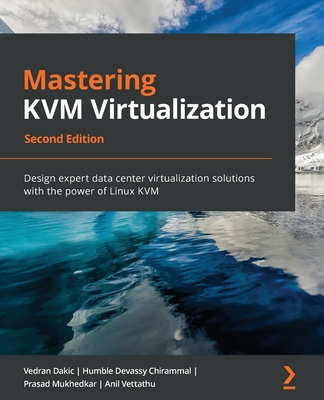買這商品的人也買了...
-
 Linkers and Loaders (Paperback)
Linkers and Loaders (Paperback)$2,480$2,430 -
 UNIX Systems for Modern Architectures: Symmetric Multiprocessing and Caching for Kernel Programmers
UNIX Systems for Modern Architectures: Symmetric Multiprocessing and Caching for Kernel Programmers$2,430$2,309 -
 人月神話:軟體專案管理之道 (20 週年紀念版)(The Mythical Man-Month: Essays on Software Engineering, Anniversary Edition, 2/e)
人月神話:軟體專案管理之道 (20 週年紀念版)(The Mythical Man-Month: Essays on Software Engineering, Anniversary Edition, 2/e)$480$379 -
 Linux Device Driver Programming 驅動程式設計
Linux Device Driver Programming 驅動程式設計$690$538 -
 程式設計師的自我修養-連結、載入、程式庫
程式設計師的自我修養-連結、載入、程式庫$580$493 -
 Debug Hacks 除錯駭客 -- 極致除錯的技巧與工具
Debug Hacks 除錯駭客 -- 極致除錯的技巧與工具$580$458 -
 Binary Hacks -- 駭客秘傳技巧一百招
Binary Hacks -- 駭客秘傳技巧一百招$580$458 -
 無瑕的程式碼-敏捷軟體開發技巧守則 + 番外篇-專業程式設計師的生存之道 (雙書合購)
無瑕的程式碼-敏捷軟體開發技巧守則 + 番外篇-專業程式設計師的生存之道 (雙書合購)$940$700 -
 Linux 系統程式設計, 2/e (內容涵蓋 Linux Kernel 3.0) (Linux System Programming: Talking Directly to the Kernel and C Library)
Linux 系統程式設計, 2/e (內容涵蓋 Linux Kernel 3.0) (Linux System Programming: Talking Directly to the Kernel and C Library)$780$616 -
 Linux Kernel Hacks 改善效能、提昇開發效率及節能的技巧與工具
Linux Kernel Hacks 改善效能、提昇開發效率及節能的技巧與工具$680$537 -
 Linux 指令大全 (The Linux Command Line: A Complete Introduction)
Linux 指令大全 (The Linux Command Line: A Complete Introduction)$590$466 -
 並行之美學-撰寫平行應用程式的新手指南 (The Art of Concurrency: A Thread Monkey's Guide to Writing Parallel Applications)
並行之美學-撰寫平行應用程式的新手指南 (The Art of Concurrency: A Thread Monkey's Guide to Writing Parallel Applications)$580$458 -
 Deep Learning (Hardcover)
Deep Learning (Hardcover)$1,650$1,617 -
 Beyond BIOS: Developing with the Unified Extensible Firmware Interface, 3/e (Paperback)
Beyond BIOS: Developing with the Unified Extensible Firmware Interface, 3/e (Paperback)$3,500$3,325 -
 從 Paxos 到 Zookeeper:分散式一致性原理與實例 (舊名: 撐起14億人電商的技術機密:用Paxos及ZooKeeper打造分散叢集)
從 Paxos 到 Zookeeper:分散式一致性原理與實例 (舊名: 撐起14億人電商的技術機密:用Paxos及ZooKeeper打造分散叢集)$580$493 -
 $658精通 Linux 內核智能設備開發核心技術
$658精通 Linux 內核智能設備開發核心技術 -
 $1,948Hands-On Booting: Learn the Boot Process of Linux, Windows, and Unix (Paperback)
$1,948Hands-On Booting: Learn the Boot Process of Linux, Windows, and Unix (Paperback) -
 System Design Interview – An Insider's Guide (Paperback)
System Design Interview – An Insider's Guide (Paperback)$1,650$1,568 -
 軟體架構原理|工程方法 (Fundamentals of Software Architecture: A Comprehensive Guide to Patterns, Characteristics, and Best Practices)
軟體架構原理|工程方法 (Fundamentals of Software Architecture: A Comprehensive Guide to Patterns, Characteristics, and Best Practices)$680$537 -
 資料密集型應用系統設計 (Designing Data-Intensive Applications: The Big Ideas Behind Reliable, Scalable, and Maintainable Systems)
資料密集型應用系統設計 (Designing Data-Intensive Applications: The Big Ideas Behind Reliable, Scalable, and Maintainable Systems)$980$774 -
 $2,280Parallel and High Performance Computing (Paperback)
$2,280Parallel and High Performance Computing (Paperback) -
 設計重構:25個管理技術債的技巧消除軟體設計臭味 (Refactoring for Software Design Smells: Managing Technical Debt)
設計重構:25個管理技術債的技巧消除軟體設計臭味 (Refactoring for Software Design Smells: Managing Technical Debt)$520$406 -
 軟體架構師全方位提升指南|數位轉型企業中架構師角色的新定義 (The Software Architect Elevator: Redefining the Architect's Role in the Digital Enterprise)
軟體架構師全方位提升指南|數位轉型企業中架構師角色的新定義 (The Software Architect Elevator: Redefining the Architect's Role in the Digital Enterprise)$580$458 -
 軟體架構:困難部分 (Software Architecture: The Hard Parts: Modern Trade-Off Analyses for Distributed Architectures)
軟體架構:困難部分 (Software Architecture: The Hard Parts: Modern Trade-Off Analyses for Distributed Architectures)$780$616 -
 Linux 網路內功修煉 - 徹底了解底層原理及高性能架構
Linux 網路內功修煉 - 徹底了解底層原理及高性能架構$780$616
相關主題
商品描述
Get a novel perspective on Linux containers and understand the world of virtualization. This book takes you down the rabbit hole to discover what lies below the API. You'll go on a journey of virtualization and see how containers are realized in the Linux world. Linux Containers and Virtualization details the data structures within the Linux kernel which make up Linux containers.
You will start with the fundamentals of virtualization including how different resources such as memory, CPU, network, and storage are virtualized. Then you will move on to hypervisors and virtualization using the Kernel virtual Machine (KVM) and Quick Emulator (QEMU). Next, you will learn about Linux namespace, cgroups, and layered file systems, which are the essential building blocks of Linux containers. The explanation traverses the Linux kernel codebase to show how these are realized in the Linux kernel. In the final chapter, you will code your own container by applying the concepts learnt in the previous chapters.
On completion of the book, you will have the knowledge to start coding a Linux container.
What You Will Learn
- Understand the basics of virtualization
- Discover how the Linux kernel supports virtualization
- See how the evolution of the Linux kernel and CPUs led to the creation of containerization technologies
- Develop the ability to create your own container framework
Who This Book Is For
Developers working on virtualized software deployment and containers. Architects designing platforms based on a container runtime as well as DevOps professionals who want to get a microscopic view on how containers and virtualization work would find the book useful.
商品描述(中文翻譯)
獲得對 Linux 容器的新穎視角,並了解虛擬化的世界。本書將帶您深入探索 API 之下的內容。您將展開一段虛擬化的旅程,了解容器在 Linux 世界中的實現。Linux Containers and Virtualization 詳細介紹了構成 Linux 容器的 Linux 核心內部數據結構。
您將從虛擬化的基本原理開始,包括如何虛擬化不同的資源,如記憶體、CPU、網絡和存儲。接著,您將學習使用 Kernel Virtual Machine (KVM) 和 Quick Emulator (QEMU) 的虛擬機監控器和虛擬化技術。然後,您將了解 Linux 命名空間、cgroups 和分層檔案系統,這些都是 Linux 容器的基本構建塊。解釋將穿越 Linux 核心的代碼庫,以展示這些是如何在 Linux 核心中實現的。在最後一章中,您將通過應用前幾章學到的概念來編寫自己的容器。
完成本書後,您將具備開始編寫 Linux 容器的知識。
您將學到什麼
- 了解虛擬化的基本概念
- 發現 Linux 核心如何支持虛擬化
- 了解 Linux 核心和 CPU 的演變如何導致容器化技術的創造
- 培養創建您自己的容器框架的能力
本書適合誰閱讀
本書適合從事虛擬化軟體部署和容器的開發人員。設計基於容器運行時的平台的架構師,以及希望深入了解容器和虛擬化工作原理的 DevOps 專業人士,將會發現本書非常有用。
作者簡介
Shashank Mohan Jain has been working in the IT industry for around 20 years mainly in the areas of cloud computing and distributed systems. He has keen interests in virtualization techniques, security, and complex systems. Shashank has 25 software patents (many yet to be published) to his name in the area of cloud computing, IoT, and machine learning. He is a speaker at multiple reputed cloud conferences. Shashank holds Sun, Microsoft, and Linux kernel certifications.
作者簡介(中文翻譯)
Shashank Mohan Jain 在資訊科技產業工作了約 20 年,主要專注於雲端運算和分散式系統。他對虛擬化技術、安全性和複雜系統有濃厚的興趣。Shashank 在雲端運算、物聯網 (IoT) 和機器學習領域擁有 25 項軟體專利(許多尚未公開)。他是多個知名雲端會議的演講者。Shashank 擁有 Sun、Microsoft 和 Linux 核心的認證。











